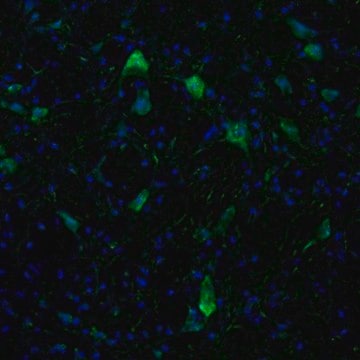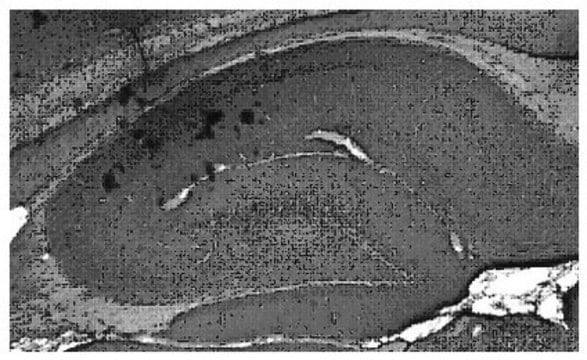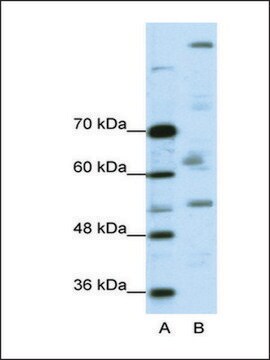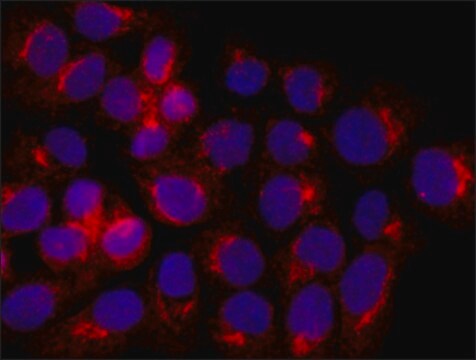일반 설명
We are committed to bringing you greener alternative products, which adhere to one or more of The 12 Principles of Green Chemistry.This antibody is Preservative-free, produced without the harm or sacrifice of animals and exceptionally stable to allow for ambient shipping and storage if needed and thus aligns with "Waste Prevention", "Designing Safer Chemicals" and "Design for Energy Efficiency".
Click here for more information.
ZooMAb antibodies represent an entirely new generation of recombinant monoclonal antibodies.
Each ZooMAb antibody is manufactured using our proprietary recombinant expression system, purified to homogeneity, and precisely dispensed to produce robust and highly reproducible lot-to-lot consistency. Only top-performing clones are released for use by researchers. Each antibody is validated for high specificity and affinity across multiple applications, including its most commonly used application. ZooMAb antibodies are reliably available and ready to ship when you need them.
Learn more about ZooMAb here.특이성
Clone 1G5 is a ZooMAb rabbit recombinant monoclonal antibody that specifically detects Synapsin-1. It targets an epitope within 19 amino acids from the C-terminal half.
면역원
KLH-conjugated linear peptide corresponding to 19 amino acids from the C-terminal half of human Synapsin-1.
애플리케이션
Quality Control Testing
Immunohistochemistry (Paraffin) Analysis: A 1:100 dilution of this antibody detected Synapsin-1 in rat cerebellum tissue sections.Tested applicationsImmunohistochemistry (Paraffin) Analysis: A 1:100 dilution from a representative lot detected Synapsin-1 in human cerebral cortex tissue sections.Affinity Binding Assay: A representative lot of this antibody bound Synapsin-1 peptide with a KD of 8.2 x 10-8 in an affinity binding assay. Immunofluorescence Analysis: A 1:100 dilution from a representative lot detected Synapsin-1 in rat cerebellum tissue sections.Immunocytochemistry Analysis: A 1:100 dilution from a representative lot detected Synapsin-1 in E18 rat cortical neurons.Note: Actual optimal working dilutions must be determined by end user as specimens, and experimental conditions may vary with the end user
Anti-Synapsin-1, clone 1G5 ZooMAb, Cat. No. ZRB1119, is a recombinant Rabbit monoclonal antibody that specifically detects Synapsin-1 and is tested for use in Affinity Binding Assay, Immunocytochemistry, Immunofluorescence, and Immunohistochemistry.
표적 설명
Synapsin-1 (UniProt: P17600; also known as Brain protein 4.1, Synapsing I) is encoded by the SYN1 gene (Gene ID: 6853) in human. Synapsins are abundant phosphoproteins expressed primarily in the brain. Synapsins I and II are expressed at the highest levels and are specifically localized to presynaptic terminals, whereas synapsin III is expressed at very low levels and is also found in cell bodies and growth cones. Synapsins I and II are expressed at low levels at birth and their expressions progressively increase during synaptogenesis to reach a stable plateau at 1-2 months of life. The N-terminal region of all synapsin have highly conserved domains A-C, while the domains D-J in the C-terminal region differ between isoforms. Domain A is shown to interact with phospholipids and this interaction is neutralized by phosphorylation of a serine by PKA and CaM Kinase I. Domain B connects domains A and C. Domain C displays most extensive homology across synapsins and mediates many of the core functions of synapsins. Synapsin I is a homodimeric protein that is present in all nerve terminals and is associated with synaptic vesicles, located at the cytoplasmic face of these vesicles. It is involved in the regulation of neurotransmitter release. In the resting state dephospho-synapsin I bind to the transmitter vesicle and reduces the availability of vesicle to fuse with presynaptic membrane. However, in the stimulated state, phosphorylated synapsin I can achieve a fusion-ready state. Synapsin I is shown to be a substrate for at least four different protein kinases and phosphorylation at serine 9 is reported to dissociate synapsin from synaptic vesicles. This ZooMAb recombinant monoclonal antibody, generated by our propriety technology, offers significantly enhanced specificity, affinity, reproducibility, and stability over conventional monoclonals. (Ref.: Song, S-H., and Augustine GJ (2015). Mol. Cells. 30; 38(11); 936-940).
물리적 형태
Purified recombinant rabbit monoclonal antibody IgG, lyophilized in PBS with 5% Trehalose, normal appearance a coarse or translucent resin. Contains no biocide or preservatives, such as azide, or any animal by-products. Larger pack sizes provided as multiples of 25 μL.
재구성
30 μg/mL after reconstitution at 25 μL per vial. Please refer to guidance on suggested starting dilutions and/or titers per application and sample type.
저장 및 안정성
Recommend storage of lyophilized product at 2-8°C; Before reconstitution, micro-centrifuge vials briefly to spin down material to bottom of the vial; Reconstitute each vial by adding 25 μL of filtered lab grade water or PBS; Reconstituted antibodies can be stored at 2-8°C, or -20°C for long term storage. Avoid repeated freeze-thaws.
법적 정보
ZooMAb is a registered trademark of Merck KGaA, Darmstadt, Germany
면책조항
Unless otherwise stated in our catalog or other company documentation accompanying the product(s), our products are intended for research use only and are not to be used for any other purpose, which includes but is not limited to, unauthorized commercial uses, in vitro diagnostic uses, ex vivo or in vivo therapeutic uses or any type of consumption or application to humans or animals.









